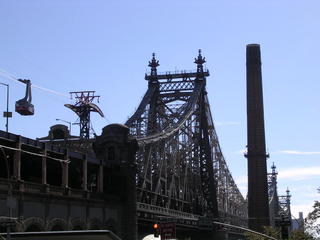
Rolf and I partnered up to check out the technology as well as the floating island. Due to the fact that I had to make a presentation to the Applications class this week, I let Rolf pick the technology. He suggested the Roosevelt Island tramway, which I thought was a great idea. I had never taken the tram nor gone to Roosevelt Island for that matter. Not only was it in keeping with the island theme, the tram positioned us perfectly to see the Robert Smithson piece.
I met Rolf at the Manhattan base of the tram early Saturday morning. We took a few photos from street level. Rolf experimented with his camera (which he’d checked out from the ER.) I had my own: a trusty Nikon Coolpix 3100. Rolf had a little difficulty figuring out the features on his camera, but this was most likely caused by his unfamiliarity with the apparatus. I keep my camera on the auto settings for most cases and usually get fine results.
To access the tram, we crossed a small plaza to the station. After climbing a flight of steps, we reached a platform. There was a window at the top of the staircase showcasing the mechanism that propels the tram above and across the river. We could see not only the giant cast iron wheels and the steel cable, but also the various other subsystems that help guide the cable around the wheels.
The tram is operated as part of the metro system, so a metro pass is needed to board. As I made my way through the turnstyle my card was rejected due to lack of funds. This is something that has always bothered me abought this metro system. There is no way of looking at a metro pass card to decipher the value remaining on it. When a rider purchases a $10 metro card, the pass allows entry into the system six times. It is up to the rider to mentally deduct the times the pass was used in order to anticipate the need to purchase a new one. If the rider loses track, he or she is faced with two options: the first and seemingly most popular, is to go for broke and try the ticket as one attempts to enter the subway system. This is a dangerous proposition in a busy station, particularly when there is a line of angry commuters piling up instantly behind anyone unlucky enough to have lost this gamble. The second option is to search out a card reader in some remote and random location in the station, say a quick prayer to the gods of transportation that the card reader might actually be functioning, then slide the pass through to see if it has any value.
Another little bit of technology that annoyed me was my experience with my camera’s batteries. They died on me when I was attempting the greatest shot of all time. Of course, I’d had ample warning, both through the camera’s graphical interface as well as through its behavior. It was also irritating dealing with flickr.com, yahoo.com and all the new passwords I had to develop (I think that I have about a dozen new ones since beginning ITP.)
But the metro pass thing really gets to me. There’s got to be a better way.
Photos can be found at:
http://www.flickr.com/photos/taitpcomlab/


 _/img>_/h3>
_/img>_/h3>
